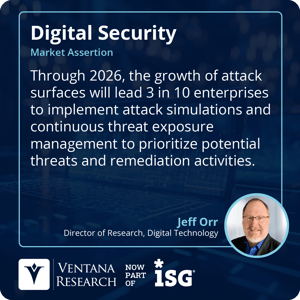Cyber threats are becoming more sophisticated and pervasive, posing a major challenge for CIOs and IT leaders. To protect their digital assets and drive business growth, they need a new approach to security: Continuous Threat Exposure Management (CTEM). CTEM software continuously monitors and manages the enterprise’s exposure to cyber risks, enabling a swift and effective response to any security incident. In this analyst perspective, we will explore how CTEM software works, why it is essential in today’s IT landscape and how it can align with broader business objectives.
The IT landscape has changed dramatically in recent years, with the adoption of cloud services, the internet of things (IoT) and remote work. These trends have increased the complexity and vulnerability of the enterprise network, creating more opportunities for cybercriminals to exploit. Ventana Research asserts that through 2026, the growth of attack surfaces will lead 3 in 10 enterprises to implement attack simulations and CTEM to prioritize potential threats and remediation activities.
complexity and vulnerability of the enterprise network, creating more opportunities for cybercriminals to exploit. Ventana Research asserts that through 2026, the growth of attack surfaces will lead 3 in 10 enterprises to implement attack simulations and CTEM to prioritize potential threats and remediation activities.
Traditional security tools, such as firewalls and antivirus software, are not enough to cope with these challenges. They are reactive, often detecting threats only after they have breached the network. They are also siloed, lacking the ability to provide a comprehensive view of the enterprise’s security status. CTEM software is different. It is proactive, identifying potential vulnerabilities before they can be exploited. It is also holistic, providing a real-time overview of the organization’s exposure to cyber risks across all domains. By using CTEM software, IT leaders can gain visibility, control and agility over their security operations.
CTEM software offers a modernized approach that enables CIOs and IT leaders to proactively manage their cybersecurity posture. Unlike traditional security tools that rely on periodic scans, signatures and patches, CTEM software continuously monitors and manages the enterprise’s exposure to cyber risks across all domains, including cloud, IoT and remote work. CTEM software offers several key benefits that make it a viable choice for modernized IT environments:
- Real-time threat visibility: CTEM software provides a real-time overview of the enterprise’s threat landscape, identifying potential vulnerabilities and threats as they emerge. This allows for immediate detection and prioritization of risks, reducing the window of opportunity for attackers. In contrast, traditional tools such as firewalls and antivirus software may not detect a threat until after it has breached the network, increasing the likelihood of data loss or compromise.
- Improved response capabilities: CTEM software not only identifies threats but also provides automated response capabilities. This means that CTEM software can remediate or mitigate identified threats without requiring human intervention. This is a significant advancement over traditional tools, which often require manual processes for threat resolution. With CTEM software, the time between threat detection and response is reduced, limiting potential damage and disruption.
- Enhanced security posture: By providing a comprehensive view of the enterprise’s threat landscape and automating threat response, CTEM software enhances the overall security posture of the enterprise. It enables the organization to proactively manage cybersecurity, rather than reacting to threats as they occur. This proactive approach is more effective and efficient than the reactive stance of traditional security measures, which often result in wasted time and resources.
- Consolidation of security functions: CTEM software can also consolidate various security functions that might be spread across multiple tools in a traditional setup. For example, CTEM software can integrate vulnerability assessment, threat detection, incident response and compliance reporting into a single platform. This consolidation can simplify security operations and reduce the complexity of managing multiple applications.
CTEM is needed in today’s landscape because traditional security measures are not enough, and cyber threats are constantly evolving. By providing real-time threat visibility and improved response capabilities, CTEM tools enable organizations to proactively manage their cybersecurity, reducing the risk of costly data breaches. This not only enhances their digital security posture but also aligns with their business objectives by minimizing downtime and ensuring business continuity.
Regards,
Jeff Orr

 complexity and vulnerability of the enterprise network, creating more opportunities for cybercriminals to exploit. Ventana Research asserts that through 2026, the growth of attack surfaces will lead 3 in 10 enterprises to implement attack simulations and CTEM to prioritize potential threats and remediation activities.
complexity and vulnerability of the enterprise network, creating more opportunities for cybercriminals to exploit. Ventana Research asserts that through 2026, the growth of attack surfaces will lead 3 in 10 enterprises to implement attack simulations and CTEM to prioritize potential threats and remediation activities.








